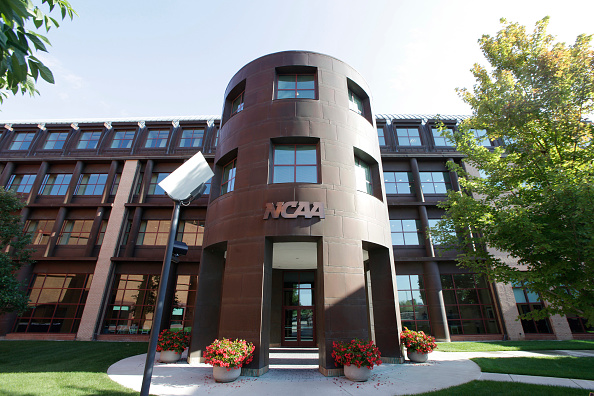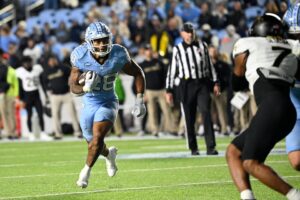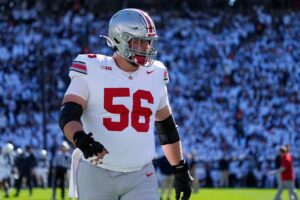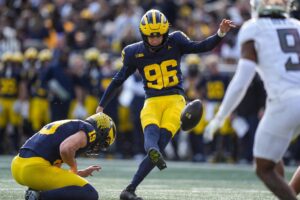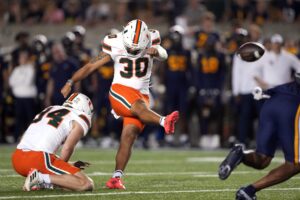(EDITORIAL): NIL is dead for college football already. Long live the Collectives. Maybe in various forms of media coverage of the ever-changing college sports landscape, you may have been under the illusion that they are intrinsically tied together. NIL, or Name/Image/Likeness, was supposed to be the name of the game going forward. But just as soon as it became legal, both in the literal sense, and the NCAA sense, the Collectives were being built and ready to take over the game. While NIL had a specific linear purpose, the Collectives represent a new form of college football’s legalized money laundering.
College Football’s Legalized Money Laundering Wipes Out NIL
The starting point is the starting point whether we are talking NIL or Collectives. The NCAA is to blame. The day of reckoning that allowed college athletes to make money in one form or another was well on its way. The person who didn’t see the runaway train was NCAA president Mark Emmert. In a tenure that is marked by abject failure, his biggest misstep will be the hubris he showed in truly believing that he was going to win the lawsuits aimed at college sports’ antiquated system of “amateurism.”
Emmert’s Legal Abyss
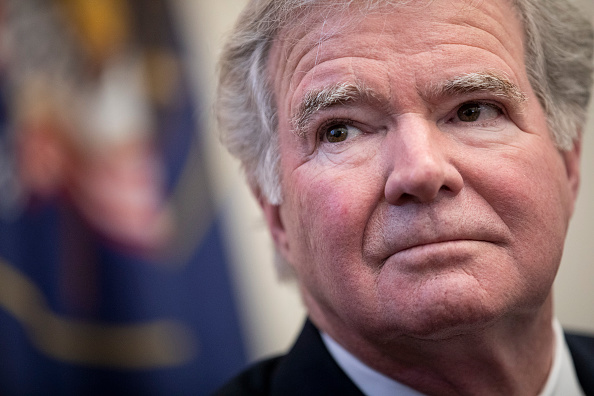
The writing should have been on the wall well in advance of ever stepping foot into a deposition. O’Bannon v. NCAA challenged the idea that athletes did not have the same right as every other student on campus, or for that matter every other citizen in this country. The right of ownership of their name, likeness, and image. The NCAA had been making tens of millions every year using likenesses of current and past athletes, and giving them not a dime because they were “amateur” athletes. As the NCAA lost at the lower court levels, the appellate level, and beyond, Emmert had the chance to put the NCAA in a spot of forward-looking compromise. But he was certain he would win at the federal level. The Ninth Circuit Court upheld O’Bannon’s anti-trust suit, and the Supreme Court unanimously upheld that ruling.
In Alston v. NCAA, SCOTUS ruled, again unanimously, against the NCAA. Capping compensation benefits for athletes, that were not capped for other scholarship students was a violation of the Sherman Act.
Emmert spent tens of millions of dollars in legal fees on cases that first-year law students could have told him he was going to lose. And he got beat 9-0 both times. Athletes were not to be held under a different onerous system than other students, just because they were under the jurisdiction of the NCAA.
What NIL Was Supposed To Be
That got us to NIL and figuring out how to compensate the athletes in all sports for marketers who wanted to use their name, image, and likeness. The NCAA took a hard pass on creating sweeping national rules for college athletes. It still had an ice pack on its eyes from the legal beating it took. They took the general guard rails that already existed. The NIL money cannot be a pay-for-play system. Schools cannot use it as an inducement to get athletes to attend their universities. And the schools cannot be involved in the financial part. The money had to go directly from the marketer using the athlete to the athlete or their allowable NIL agent. That was it.
For more specific rules, the NCAA pleaded with Congress for help and knew that states were well on the way to creating their own laws to govern the schools in their jurisdiction.
So how is NIL working with the marketers paying the athletes directly, the schools playing no role, and the rules against inducement? It is a humiliating failure. It is so bad, that the intended model barely exists and is about to be completely obscured by Collectives.
The Real NIL
To be sure there are still some arrangements that fall under the intended structure. Texas Longhorns running back Bijan Robinson just signed a NIL with a Lamborghini dealership in Austin, Texas. The messages have become so muddled that many media outlets and social media raconteurs published that he signed a deal with Lamborghini. In a world where facts matter less and less, we are here to report that there is a massive difference between signing a NIL deal with Bruce Knox’s local car dealership and signing one with the multi-billion dollar European car manufacturer. The former is the truth.
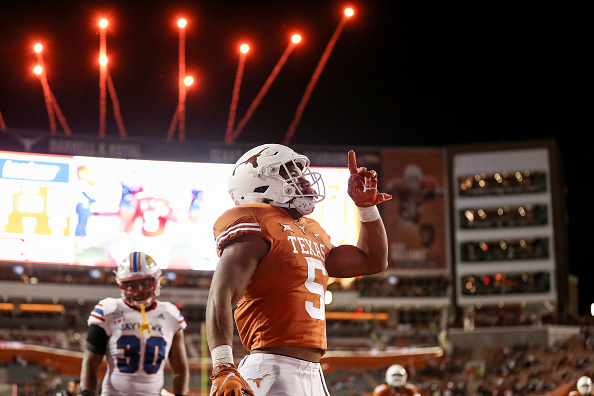
UCLA backup quarterback Chase Griffin has worked the system like an orchestral maestro. He may wind up being third-string this season, but he is engaging and completely marketable. Add in that he finished his undergrad in less than three years and has been on his Master’s degree since then, making him viable for messaging purposes. Then he took the money from his first modest NIL offer and rolled it into a social awareness marketing of his own. He is giving over money to the regional food bank. The “wokeness” with which he worked, caused other marketers to want to jump in with him. The result is that Griffin has in the ballpark 10 sponsors all working together. He is on every NIL panel that you could imagine as a spokesperson.
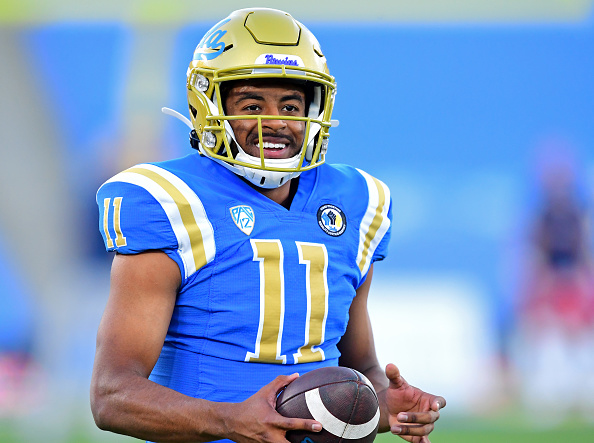
Schools Panic
The successful cases of NIL literalism are few and far between. Schools got worried that they were going to lose the new era of an arms race in college sports. First, it was the practice and training facilities that needed to be built with hundreds of millions in donor money. Then along came NIL. And it came along in the same breath as the transfer portal. So while the two are supposed to be operating systems distinct from each other, they are forever tied together. “NIL” money, that is to say, money from the Collectives, is now being used to induce athletes into or out of the portal.
In the rush to stay up in the new arms race, the schools have let the barons back inside the gates. SMU would probably like to retroactively look at its death penalty from the NCAA in 1987. Having players on the payroll is fully legal and apparently, it no longer matters where the money is coming from.
Twenty-eight states have NIL legislation on the books. Some of the laws are in effect now. Others are soon to be. Still, other states have legislation in progress. The state of Alabama went the other direction. The state lawmakers decided that having laws was too restrictive for its universities and rescinded the NIL laws back in February.
In every state that has laws, there are mandates that forbid the use of the money as an inducement to get a recruit to come to that university. That is simply an add-on to the NCAA guide rails.
The Collectives
Yet, that is the express purpose of nearly every Collective being used by and on behalf of the schools. Instead of “Marketer A” getting exact deliverables from “Athlete A.” and paying him or her directly, they can now pool their money with other sponsors, donors, and yes, boosters. The bigger the pot, the better the recruiting message to elite athletes about how much money they can make at a given school.
But here is where NIL and Collectives start to part ways. The NIL was supposed to provide tit-for-tat deliverables from player to marketer in exchange for the money agreed upon.
Collectives have no such mission. Texas, Oklahoma, and others are reportedly paying a “stipend” to each of their offensive linemen. Maybe the Sooners’ left tackle is marketable. Maybe not. It no longer matters. It bears no resemblance to actual NIL because the only deliverable he is providing is being the left tackle for the Sooners.
And yes, more than a couple of Collectives have acknowledged reaching out to recruits, one of the few specifics the NCAA had.
In Charity’s Name
What was supposed to be a direct sponsor to athlete revenue deal has now turned into a legalized form of money laundering. The collectives take money in from different sources. They clean it in the name of a charitable enterprise. Then send it off to athletes with little accountability to know who is getting paid what and from whose donation the money came. It is just one big piggy bank. The booster money is being laundered.
Most of the Collective are laughably registered as a 501(c)(3), or a not-for-profit charitable organization. It presumably takes some of the stink off the process. In theory, in order to get paid, the athletes will have to do a mandated amount of charitable civic work. And playing on Saturdays is not charity work. At least not for most schools. The Collectives, as a 501(c)(3), have to report on their taxes who got paid what, and what charitable work the athlete did in order to be compensated. Screw this up and your problem is not with the NCAA but with the Treasury Department. It also takes a leap of faith to believe anyone is going to get caught with bookkeeping malfeasance anytime soon.
This week, the NCAA Board of Governors approved a proposal by Ohio State athletic director Gene Smith. It calls for clamping down on NIL rules. It is designed to keep the boosters out of the system. That is easier to track and enforce with real NIL. Who is the marketer? Who is the athlete? Paperwork goes through compliance. Done.
But NIL is going the way of the Do-Do Bird in favor of Collectives, a system successfully going back to the Al Capone days. Connecting the dots on the money will be nearly impossible. “It’s clean. It’s been laundered.” – Joe Pesci, Lethal Weapon 2.


